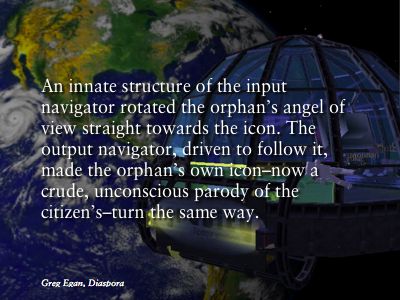
Let’s jump topics but get back to Egan’s Diaspora.
A chapter on Yatima’s birth, in the software city, describes two elements of the pre-conscious being, or fetus perhaps:
“An innate structure of the input navigator rotated the orphan’s angle of view straight towards the icon. The output navigator, driven to follow it, made the orphan’s own icon – now a crude, unconscious parody of the citizen’s – turn the same way.”
Hang on, separate output and input? We’ll be calling these grasp and reach. Reach is what you can see, grasp is what you can touch and effect. In sci-fi novels, these are often called sensors and effectors. Effectors being things like tractor beams (output), and sensors being stuff like radar (input).
In Diaspora, some cities have conventions to keep grasp and reach together and not collide input/output (IO) cursors with anyone else, other cities don’t mind. All of physics and nature is up for grabs and personally chosen. Socially, these things have to be negotiated—grasp and reach are both conventions. In individual scapes, environments within the cities, there are ways to help sync up even the perception of time.
(Incidentally, in a world where there is no built-in mortality, and everything is voluntary, what happens to rituals like funerals? The only death-cases in Diaspora are external effects that damage the physical computer that the city runs on, which is itself a spaceship, and deaths that individuals chose. Do you have a right to feel sad about a chosen death? How do you commemorate it? There’s another death state, which is more tragic. That’s when an individual edits their personality so that they don’t want to change their personality back again. They enter a closed loop of being self-contained. A dead end.)
Now, does having different physics matter? Yes. It’s built in, and the low-level nature alters the high-level social reality. In Second Life, a massively-multiplayer online world (perhaps you could even call it a collaborative physics simulation), your avatar, the figure of yourself in the world, is your output. But you can move your viewpoint – your camera, your reach – anywhere within the local area. We can’t do that in our physical world—our eyes are inset in our body. In Second Life, the only indication that you have moved your reach is that your avatar’s head faces in that direction.
The background to this slide is an in-game night club called the Gravity Space Station.